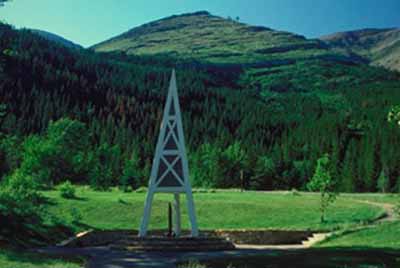First Oil Well in Western Canada National Historic Site of Canada
Waterton Lakes National Park of Canada, Alberta

General view
(© Parks Canada Agency / Agence Parcs Canada, 1993.)
Address :
Akamina Parkway, Oil City, Waterton Lakes National Park of Canada, Alberta
Recognition Statute:
Historic Sites and Monuments Act (R.S.C., 1985, c. H-4)
Designation Date:
1965-05-17
Dates:
-
1901 to 1902
(Construction)
-
1902 to 1904
(Significant)
Event, Person, Organization:
-
John Lineham
(Architect)
-
Rocky Mountain Development Company
(Architect)
Other Name(s):
-
First Oil Well in Western Canada
(Designation Name)
Research Report Number:
1961-024, 1963-011, 1965-009, 1962-054, 1961-035, 2008-054
DFRP Number:
56488 00
Plaque(s)
Existing plaque: Oil City, 6 km from Waterton Townsite Akamina Parkway, Waterton Lakes National Park, Alberta
The Rocky Mountain Development Co., formed in the late 1890's by John Lineham, Allan Patrick and G.K. Leeson, commenced drilling operations on this site in 1901 and struck oil at a depth of 1024 feet in 1902. The well failed to maintain its initial flow of 300 barrels per day and, by 1904, production had dwindled to almost nothing. Further explorations in the Waterton area proved fruitless but the success, brief as it was, of this well encouraged a widespread search which led to the discovery of the Turner Valley Field in 1914.
Description of Historic Place
First Oil Well in Western Canada National Historic Site of Canada is located between Cameron Creek and Mile 5 of the Akamina Highway east of the townsite of Waterton, Alberta. It consists of a well-head opening and drill stem capped by a monument in the triangular shape of an oil derrick. Archaeological remains of the buildings and machinery associated with the operations of this site are included in the designation.
Heritage Value
First Oil Well in Western Canada was designated a national historic site of Canada in 1965 because: it was the first oil well in western Canada.
The heritage value of the first oil well in western Canada lies in its association with the western Canadian oil industry as illustrated by the remains of this early well. Western Canada's first oil well was discovered by John Lineham of the Rocky Mountain Development Co. in 1902. It had been drilling on the same site since 1901, and the oil was encountered at 1024 ft. While this was a small well that ran dry in 1904, its location signaled the presence of much larger fields that were later developed. Most of the visible remnants of the drilling operation were removed when the monument was erected over the well in 1968.
Source: Historic Sites and Monuments Board of Canada, Minutes, May 1965; Commemorative Integrity Statement, September 2000
Character-Defining Elements
Key elements that contribute to the heritage character of the site include: the location of the well in relative proximity to other oil fields in western Canada, the well-head opening with its drill stem, the drill shaft, archaeological remains associated with well operations in the 15 ft. radius surrounding the well-head opening, viewscapes to the rugged natural terrain and to sites containing evidence of historic mining activity (refuse, nearby oil pool, grave and telegraph poles).